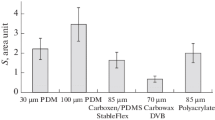Summary
1,6-Hexamethylene diamine (HDA), used as raw material in industrial manufacturing operations, was orally administered to six healthy volunteers. After acid hydrolysis of the urine by hydrochloric acid, HDA and the metabolite 6-aminohexanoic acid were quantified. HDA was determined as an ethyl-chloroformate derivative by capillary gas chromatography using thermionic specific detection (TSD), and 6-aminohexanoic acid was quantified by ion chromatography using the ninhydrin reaction. In nonhydrolysed urine, monoacetylated HDA (N-acetyl-1,6-hexamethylene diamine) and HDA, were verified as heptafluorobutyric anhydride derivatives by gas chromatography-mass spectrometry (GC-MS), in a chemical ionization mode using isobutane and ammonia as reagent gases. In hydrolysed urine, a mean of 0.28 mg (range 1–6%) of the administered dose (8.2 mg) was recovered as HDA, and a mean of 0.8 mg (range < 1–27%) as 6-aminohexanoic acid. The urinary excretion of both the determined compounds was rapid, and the principal part (> 90%) of the elimination was completed within 10 h. There was a considerable inter-individual variation in the excreted amounts, but the intra-individual variation in the excretion of HDA was limited. The subjects N-acetylator phenotype was determined by a dapsone test. Three slow acetylators excreted lower amounts (mean 2% of given dose) of HDA than three rapid ones (mean 5%).
Similar content being viewed by others
References
Beard RR, Noe JT (1981) Alipathic and alicyclic amines. In: Patty's industrial hygiene and toxicology, vol 2B: Toxicology, pp 3135–3173
Berode M, Leuenberger Ph, Savolainen H (1988) Phenotype-dependent inhibition of human α1-antitrypsin by 1,6-hexane diamine in vitro. Biochem Int 17(1):141–145
Dashiell OL, Kennedy GL (1984) The effects of fasting on the acute oral toxicity of nine chemicals in the rat. J Appl Toxicol 4:320–325
David RM, Heck H (1983) Localization of 1,6-[14C] diaminohexane (HMDA) in the prostate and the effects of HMDA on early gestation in Fisher-344 rats. Toxicol Lett 17:49–55
Egorin MJ, Zuhowski EG, Nayar MSB (1987) Gas chromatographic analysis of metabolites of the cell differentiating agent hexamethylene bisacetamide. J Chromatogr 415:148–155
Hanson A, Melander A, Wåhlin-Boll E (1981) Acetylator phenotyping: a comparison of the isoniazid and dapsone tests. Eur J Clin Pharmacol 20:233–234
Heby O, Jänne J (1981) Polyamine antimetabolites: Biochemistry, specificity and biological effects of inhibitors of polyamine synthesis. In: Polyamines in biology and medicine. Marcel Dekker Inc, New York, pp 243–310
Johannsen FR, Levinskas GJ, Ben-Dyke R, Hogan GK (1987) Subchronic inhalation toxicity of hexamethylenediamine in rats. Fund Appl Toxicol 9:504–511
Pegg AE, Conover C, Wrona A (1978) Effects of aliphatic diamines on rat liver ornithine decarboxylase activity. Biochem J 170:651–660
Rosenberg C, Savolainen H (1986) Determination in urine of diisocyanate derived amines from occupational exposure by gas chromatography-mass fragmentography. Analyst 111:1069–1071
Seiler N, Al-Therib MJ (1974) Putrescine catabolism in mammalian brain. Biochem J 144:29–35
Sittig M (1985) Handbook of toxic and hazardous chemicals and carcinogens, 2nd edn. Noyes Publications, NJ, USA
Skarping G, Dalene M, Brorson T, Sandström JF, Sangö C, Tiljander A (1990) Chromatographic determination of amines in biological fluids with special reference to the biological monitoring of amines and isocyanates.I. Determination of 1,6-hexamethylene-diamine with chloroformates and heptafluorobutyric acid anhydride using nitrogen selective detection. J Chromatogr 479:125–133
Skarping G, Smith BEF, Dalene M (1984) Trace analysis of amines and isocyanates using glass capillary gas chromatography and selective detection. III. Determination of aliphatic and alicyclic amines as perfluoro fatty acid amides using electron-capture and nitrogen-selective detection. J Chromatogr 308:89–98
Skarping G, Dalene M, Mathiasson L (1988) Trace analysis of airborne 1,6-hexamethylene diisocyanate and the related aminoisocyanate and diamine by glass capillary gas chromatography. J Chromatogr 435:453–468
Weber WW, Hein DW (1985) N-acetylation pharmacogenetics. Pharmacol Rev 37:25–79
Author information
Authors and Affiliations
Rights and permissions
About this article
Cite this article
Brorson, T., Skarping, G., Sandström, J.F. et al. Biological monitoring of isocyanates and related amines. Int Arch Occup Environ Health 62, 79–84 (1990). https://doi.org/10.1007/BF00397852
Received:
Accepted:
Issue Date:
DOI: https://doi.org/10.1007/BF00397852




